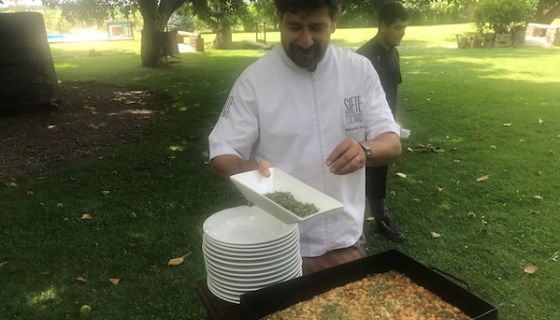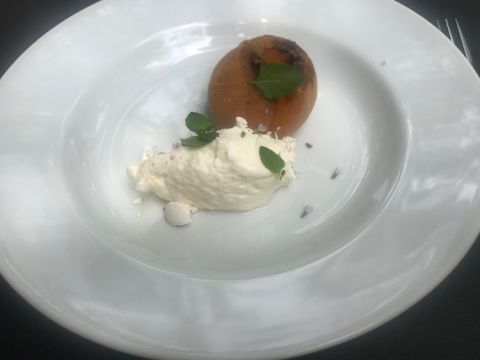I can still vividly recall my first meal in what was then one of the very few winery restaurants in the world.
It was 8 April (my birthday) and it was in the Robert Mondavi winery in Oakville, Napa Valley. The location should not surprise any reader. Robert, as well as his wife Margrit, were pioneers of the maxim that wine and food taste far better together. And also, blessed as he was with the eye of a great marketeer, he saw long before anybody else the huge potential of adding a restaurant to his winery.
As well as the date, I can still remember the name of the chef who cooked our meal – she was Annie Roberts, Margrit’s daughter, mother of one half of new-wave California wine producer Arnot Roberts. I can still remember one of the dishes, an excellent version of cappelletti with rabbit. This lunch took place over 30 years ago and until we moved out of our former house over three years ago, the menu hung on our lavatory wall. Together, of course, with a list of the wines we drank, which included a comparison of the finest from California and France.
(Mondavi believed in continuous comparison as the only way of learning. At a dinner on a previous occasion in 1982, Mondavi entertained Jancis and myself at a restaurant in St Helena together with our then six month-old daughter asleep in a Moses basket. It was when he had ordered the third bottle of top Chardonnay that Jancis tried to say that that was enough: as well as a broken night she had to be up at 6 am for the following day’s filming. Mondavi turned to her and said, quite firmly, 'But don’t you want to learn?')
Today, wineries and restaurants go together like peaches and cream. Wine tourism is universal and thriving and restaurants provide an extra and particularly special attraction. They give the owners the opportunity of getting the visitors to taste their wines in what are often the most attractive locations for any restaurant. And, as long as there is a dedicated driver, they give the visitors the opportunity to prolong their visit. With that comes the added opportunity to either buy and take a case of wine away with them or to have it delivered directly from the winery.
The winery owners of the Uco Valley in Mendoza, Argentina (about whose wines JR will be writing in a week’s time), have warmly embraced this approach, an approach that has obviously met with great success. On 13 February this year a group arrived to visit the winery at Espacio Trapiche at 9 pm, to be followed by dinner, and on the following evening the restaurant had over 100 booked for Valentine’s Night. We also ate well at Finca La Anita and DiamAndes within Clos de Los Siete, owned by the Bonnie family of Ch Malartic Lagravière in Pessac-Léognan.
But unquestionably the best meal of my stay in this enormous winegrowing region was our first lunch at the Bianchi winery, where the management had had the foresight to hire in to cook for our table of 14 a most simpatico and understanding chef.
He is Pablo del Rio, who for many years was the inspiration behind the excellent food served at Siete Cocinas in Mendoza. Del Rio is 42. He began cooking in 1998 and closed this popular restaurant after 18 years last November.
‘It became too tiring', del Rio explained to me when we shook hands before lunch, ‘and now I intend to concentrate on cooking for wineries such as today before embarking on my own place in several months’ time. Exactly when I cannot say for the moment as the restaurant will be on a farm where I’ll breed all the animals I will slaughter. And as I have come to appreciate, the big difference between being a chef in a restaurant and what I intend to be – a chef who is entirely self-sufficient – is that I cannot rely on suppliers any longer. I can put this philosophy into practice only when the animals have matured to the appropriate age. In the meantime, I must be patient.’
At this particular lunch, del Rio was able to put into practice many of the elements of putting together a menu that complements the wines that are being shown, and displayed a confidence that only a long period behind the stoves can bestow on anyone.
The first rule is that, like everything else in life, less is more. This principle, first expounded by the architect Mies van der Rohe, applies in my opinion to everything but, when applied to writing a menu, has the added advantage of staving off boredom. I am not the only person who has got up from a multi-course meal exhausted, both physically and mentally.
Secondly, if the purpose of the food is to accompany myriad wines, then why complicate and confuse the guests with myriad courses? It is difficult enough to follow one without having to keep an eye on both the food and the wines.
Thirdly, having been a chef in a very successful restaurant, del Rio exemplified one of the principal excitements of going out to eat: to be able to enjoy the kind of dish that one cannot easily cook at home. His main course was just that.
Particularly and finally, because this dish allowed del Rio to practise what he preaches: a principle underlying his cooking is to ‘keep it local’. ‘Argentina is so closely linked with beef but there are no cattle in Mendoza. The cattle are bred over 1,000 kilometres away around Buenos Aires. That is why I have prepared rabbit as your main course; they are farmed locally.’
The concisely worded menu was at everybody’s place. It began with a salad of burrata, organic tomatoes and basil that for me was highlighted by its cubes of watermelon. Then del Rio appeared walking towards us with his assistant carrying between them an enormous cast-iron rectangular dish that contained our main course, described as a ‘claypot of rice and rabbit’. He then served everybody with a smile on his face, soon replicated on the faces of all those around me. Here was a dish that was not just comforting and delicious but had plenty of crisp nuggets of blackened rice that added bite and texture. Then came dessert, a peach with the stone in, roasted in the oven, then finished for half an hour with the stone removed, served with a scoop of sweetened goat's cheese.
At the end, del Rio explained his approach possibly more succinctly than anybody else could. ‘Food should be simple', he explained, ‘because life is complicated.’
Pablo del Rio expects to be cooking at his farm Hornero, Marchieri Barroud Vineyards, Cobos Street & Ruta 7, Luján de Cuyo, from early April 2020.














